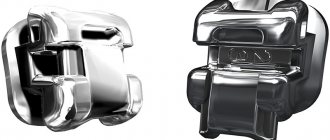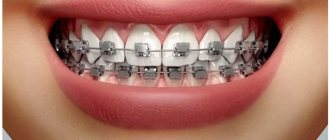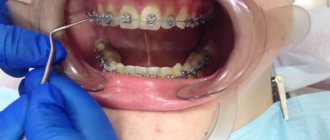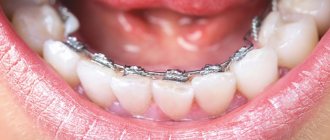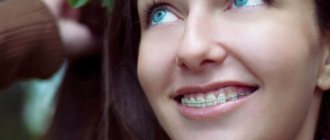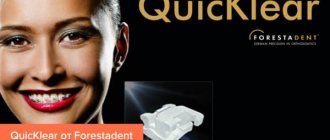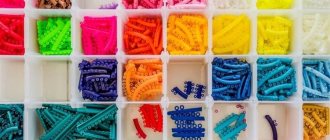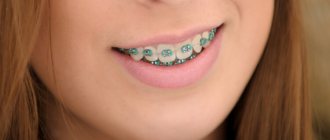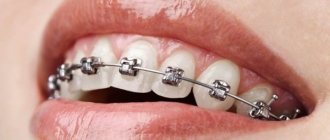January 5, 2020 Last revised: September 13, 2020 Braces
Classic braces systems are fairly voluminous structures that provide gradual displacement of teeth in the required direction due to an arch firmly attached to the braces using elastic ligatures - rubber bands. But most patients are embarrassed by the lack of aesthetics of such systems, the discomfort that occurs when such a brace system is overloaded, as well as other difficulties that arise during dental care. Specialists in the field of aesthetic dentistry, creating new types of tools for straightening the bite, tried to take these points into account as much as possible, and thus self-adjusting braces came into the arsenal of orthodontists, differing from conventional ones in the absence of any additional mechanisms.
Such braces do not require conventional ligatures. The already outdated rubber bands have been replaced by reliable latches. At the same time, an overdose of forces is almost completely eliminated, since when overloaded, the clip seems to release the arc, allowing it to move without problems like sliding doors. This also allows you to correct your bite and significantly reduce treatment time. In addition, there is no need for regular visits to the orthodontist’s office, since there is no need to change an elastic ligature that is broken/damaged during use. Self-adjusting braces are examined by an orthodontist once every couple of months - this is enough for safe and correct treatment.
The main advantages of self-regulating bracket systems
A distinctive advantage of braces is the use of small physiological forces. According to reputable doctors and other specialized specialists, this approach makes it possible to significantly reduce the trauma of the entire process of occlusion correction and can reduce treatment time by 25%.
Some self-ligating braces allow for more individualized correction, as it is possible to program the bracket system for how each tooth should be positioned. This makes the process of moving teeth much more predictable, and the result optimal.
A huge variety of such brace systems makes it possible to choose exactly the one that is best suited in each individual case. For people who value maximum functionality rather than aesthetics, orthodontists recommend durable self-ligating metal braces. And ceramic bracket systems are perfect for people who are accustomed to giving preference to aesthetics. However, there are also compromises: the same non-ligature braces, which ideally combine the strength of steel and the aesthetics of ceramics.
Advantages of using ligature-free braces
- Self-adjusting braces do not have hooks and take up very little space in the mouth. This significantly reduces adaptation time and makes oral care easier.
- Also, ligature-free braces are the only method of teeth straightening that can be offered by a doctor to a patient with periodontal disease.
- During the installation of self-ligating braces, the patient can avoid wasting his time and come for an appointment once every 3 months.
- The arc change time, thanks to the clamps, takes 10-15 minutes.
- Well, the main difference between self-ligating braces and ligature braces is that teeth are straightened with the help of the muscles of the tongue, cheeks and lips, and a positive result is achieved faster and lasts for a long time.
- Ligature-free braces apply little pressure on the oral mucosa, resulting in a reduction in trauma to almost zero.
- To successfully continue treatment, it is enough to rarely visit the doctor once every 2-3 months.
- They are made from proven and pure materials that do not interact with the environment in the oral cavity.
- The absence of ligatures in such brace systems greatly simplifies oral care for patients.
- Patients wearing such braces quickly get used to them due to their optimal size.
- When correcting your bite, you will not have to remove teeth.
- The alignment process is calculated for all teeth separately.
- Their design guarantees continuous operation of the archwire, which is why you do not have to go to a specialist to activate your braces. This is very important for patients who do not have enough time to visit the dentist.
- Self-ligating braces have a pleasant appearance.
- Removal and installation of the structure takes place as quickly as possible.
Damon braces are leaders among self-ligating systems
Damon self-ligating braces were invented by Dwight Damon, after whom they got their name. They are the standard among non-ligature structures. Let's look at what makes them superior.
- Correction of dental pathology occurs not only due to traction force, but also through the action of the facial muscles.
- The Spin Tek locking mechanism of the Damon system reduces the time required for installation and activation of the structure, and also helps to evenly distribute pressure on the teeth.
- The smooth outer surface of the brackets undoubtedly improves the adaptation process and at the same time increases the oral hygiene index.
Metal self-adjusting braces
Non-ligature metal braces are the most popular and common type of non-ligature braces. Such metal braces have long proven their effectiveness and cope well even with complex cases. They are used in the correction process even in the most difficult cases.
Such metal bracket systems are characterized by the least aesthetics, but maximum efficiency. At the moment, even patients with allergies can afford metal braces - for them, companies make special systems cast from hypoallergenic materials.
Types of Damon braces
Today, a course of orthodontic correction using the Damon self-ligating brace system can be carried out both for patients who value primarily aesthetics, and for those who place increased demands on the functionality and strength of the structure. Having undergone a number of improvements, the Damon line has expanded significantly, and as of today includes the following variations.
Metal braces
Damon 3 MX metal braces are made of stainless steel, which provides good physical properties. Optimization of the adaptation period is achieved due to the influence of low forces. And the rounded contours and smoothness of the profile prevent the occurrence of injuries to the mucous membrane. The presence of an additional vertical groove allows the installation of hooks, thereby “expanding the capabilities of the system.”
Damon Q braces are a relatively new achievement from Ormco. Compact dimensions, strength, reliability of Spin Tek fasteners, exquisite design - thanks to all these characteristics, treatment using Damon Q reaches a whole new level. But not everyone can afford a correction; prices vary between 140-150 thousand rubles.
Combined systems
The Damon 3 system includes ceramic brackets, but the groove and clip-latch are made of metal. This modification provides a solution to three problems at once. Firstly, good aesthetics are achieved. Secondly, a low coefficient of friction promotes faster tooth movement. Thirdly, the presence of metal fixation increases the functional properties of the system.
Aesthetic braces
Damon Clear braces are the best option for people who primarily care about aesthetics. Made from aluminum oxide polycrystals, which makes them appear invisible on the teeth to others. These are all-ceramic structures, there are no metal elements at all. But what is important: sapphire self-ligating braces are installed in the frontal area of the teeth, and stronger brackets are fixed in the lateral area. These can be either combined structures (Damon 3) or solid metal systems (Damon Q).
Advantages
The main advantages of non-ligature leveling systems include:
- Wearing comfort. The smoothed edges of the products, the absence of hooks and ligatures on them make the design more convenient. And due to the low load, wearing them significantly reduces pain.
- Simplified care. Self-ligating braces are easier to care for than ligature braces, because they do not have additional parts that can complicate oral hygiene and cause a strong accumulation of food debris and plaque, which can cause caries.
- Can be installed for periodontitis.
- Improved external properties. The ligatures used for ligature braces gradually become colored, and due to their absence in non-ligature designs, this drawback is eliminated.
- Visits to the doctor are made less frequently (every 1.5-2 months). The appointment takes approximately 20 minutes. After all, the doctor only needs to replace the arch and examine the oral cavity. And thanks to the retaining clips, replacing the arch is quick.
- Installation in one visit to the doctor. In this case, the patient does not feel pain and injury is excluded. Removal of the systems is also easy and without discomfort.
- Quickly addictive.
- Individual designs are manufactured taking into account all the patient’s characteristics.
- They put less pressure on the teeth than ligature systems.
- By reducing the friction force, bite correction occurs faster.
- There is no need to remove permanent teeth before installation.
Well-known manufacturers of self-ligating braces
Today, many companies are engaged in the production of non-ligature braces. There are models that have appeared a long time ago and those that were developed more recently, but have already gained great popularity.
Let's consider the most popular non-ligature models:
- “Clarity SL” - they are made from a material that is invisible on the teeth, so the aesthetic characteristics of the product are very high.
- “Damon” (3MX, Q) - have small sizes, so they are very comfortable to wear. The braces are equipped with an original cap and smoothed edges. Good even for the treatment of complex bite defects.
- “Smart Clip” - equipped with special snap-on devices, so you can select the arc force in them. Due to this, a unique therapeutic effect is achieved.
- “In Ovation” - equipped with a convenient locking mechanism, they have several modifications (ceramic, metal and combined).
Ligature and non-ligature bracket systems - key differences
The design principle of all types of braces is the same. These orthodontic appliances consist of the following elements:
- bracket plates, which are attached to the enamel of each tooth using a special adhesive composition;
- power arch fixed on bracket plates;
- fasteners with which the arch is attached to the braces.
Fixing the power element on the tooth enamel can be done either by means of small clasps with grooves for the arc or using ligatures. Bracket systems with locking fasteners are called non-ligating or self-ligating. Devices with the fixation of a power arc on ligatures are called ligature bracket systems. In the photo: the patient on the left is wearing ligature braces, on the right is non-ligature braces.
There are several types of ligatures for braces:
- metal – the archwire is attached to the bracket plate using a thin wire. The fastening is quite rigid, so it is used in the presence of complex pathologies of occlusion. The wire is made of either medical steel, silver, or alloys of aluminum with bronze or beryllium;
- elastic – the arc is fixed using polymer rings. Depending on the wishes of the patient, they can be transparent, single-color or different colors (as in the photo above).
Installation of braces
Installation of self-regulating orthodontic systems is carried out over several sessions. At the first visit, the doctor assesses the condition of the oral cavity and determines the nature of the anomaly.
If necessary, measures are taken to eliminate dental pathologies. Orthodontic appliances are only placed on healthy teeth, so it is important to treat cavities and other diseases first. The doctor also carries out professional cleaning of the enamel, during which all plaque is removed.
If treatment is not carried out, then after the first visit the patient is given an approximate scheme for correcting the bite. A general treatment plan is drawn up during the follow-up visit.
The nature of the anomaly is determined by a photo of the patient’s head (front and profile), as well as by a panoramic photograph of the teeth and an x-ray of the skull. Already at this stage, the orthodontist can determine the duration of the correction.
On this topic
- Braces
Details about what is better: braces or plates
- Maria Konstantinovna Tevs
- October 5, 2020
After agreeing on the price, the doctor makes an impression of the dentition. Based on the resulting model, a bracket system is then manufactured.
There are two ways to fix orthodontic structures:
- straight, when each bracket is attached to a tooth;
- indirect, involving the use of a special mouthguard.
More often they resort to the direct installation method. At the same time, the use of silicone trays ensures maximum adherence of braces to the teeth. With the indirect installation method, the orthodontist first fixes the structure on the impression. After that, he transfers it to the mouthpiece.
Before installing braces, the teeth are washed and dried. Next, a primer and a special orthodontic glue (adhesive) are applied to the enamel, ensuring reliable fixation of the structure.
Each bracket is then secured to a tooth. Once the installation is complete, the orthodontist removes excess adhesive. The adhesive, under the influence of acids contained in food products, changes the color of the enamel.
At the end of the procedure, the teeth undergo light polymerization, due to which the adhesive composition hardens. The installation of an orthodontic structure takes no more than two hours.
